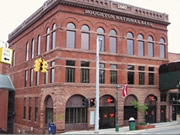From the 1880s to the 1920s, John Scott (1850–1928) was one of Michigan’s premier architects. He worked throughout Michigan, and his most popular buildings were public buildings featuring a Richardsonian Romanesque or Classical Revival style of architecture. BiographyJohn Scott was born in 1850 in Ipswich, England, where he trained to be a professional architect. His younger brother, Arthur, shared his interest, and they both decided to continue to practice architecture in the United States. In 1875 they moved to Detroit to open their firm.1 They began by taking up small-scale projects but quickly advanced to large-scale commercial buildings. By the 1880s John Scott & Company designed large-scale banks, school buildings, and other public buildings.2 By 1886 Scott’s business generated enough revenue for him to design his own house. Located on Ferry Street in Detroit, it was a Queen Anne-style house using very elaborate details and rich materials.3 In 1888, John Scott & Company designed the Gogebic County Courthouse in Bessemer, Michigan. This majestic Richardsonian Romanesque building used rough-faced Jacobsville sandstone. The hip-roofed building had a square tower with a round-arched entrance. The Wayne County Building, Scott’s largest project, was built in downtown Detroit in 1902 for commercial and government operations.4 At this point in his career he and his firm started working with several other architects and architectural firms. One of his biggest joint efforts was in the development of the Cadillac Hotel in Detroit, with Louis Kemper. In the 1920s Scott relocated his company to the Dime Savings Bank Building in Detroit. For more information on Scott, see The Biographical Dictionary of Architects in Canada, 1800-1950. John Scott & Company continued until Scott retired and moved to Rochester in 1926. His brother also retired and moved to Windsor, Ontario. On December 5, 1928, John Scott passed away.5
|


